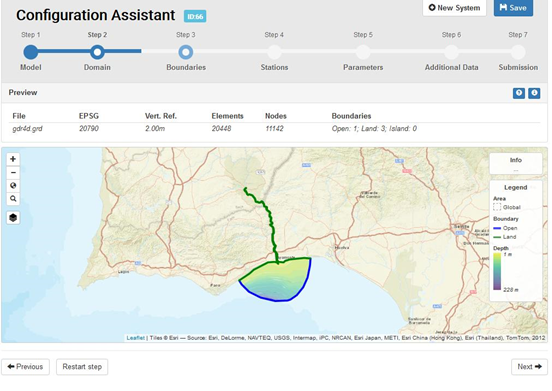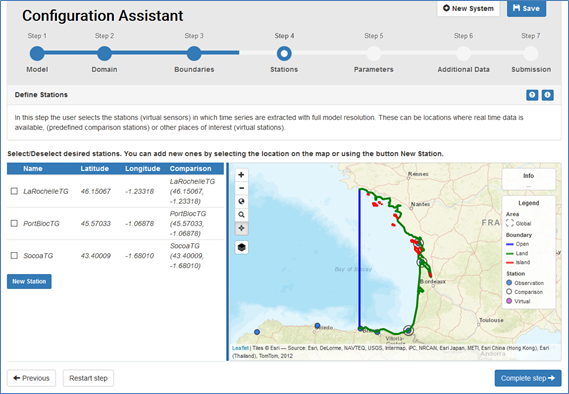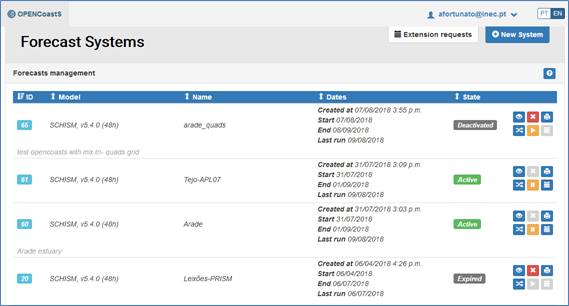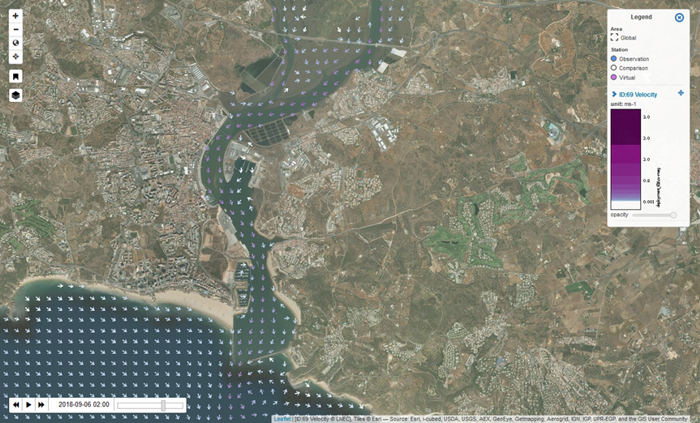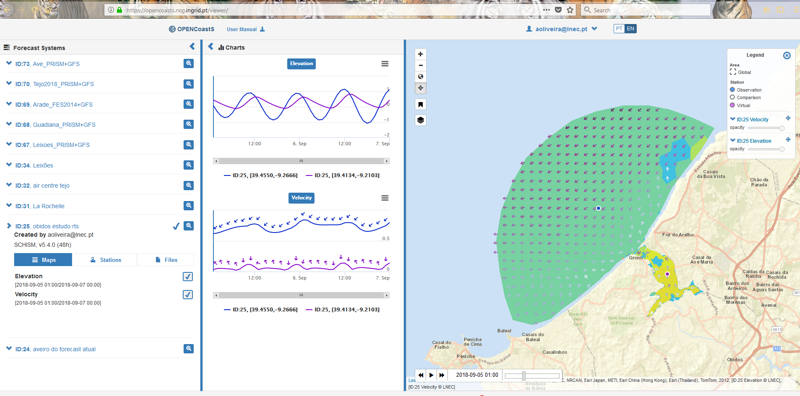The OPENCoastS service assembles on-demand circulation forecast systems for selected coastal areas and keeps them running operationally for a period defined by the user. This service generates daily forecasts of water levels, velocities, salinity, temperature, fecal contamination indicators and wave parameters over the region of interest for 48 hours, based on numerical simulations of all relevant physical and biological processes. Forcing conditions at the boundaries and over the domain are defined by the user from regional and global forecast repositories. Automatic comparison with quasi-real-time in-situ sensor data can be performed at EMODnet tidal stations, and processed Sentinel images can be provided to assess inundation forecasts.
More Information
The OPENCoastS service is available for use in: https://opencoasts.a.incd.pt/.
The users manual is available here.
The service can also be installed in a user-selected infrastructure. The OPENCoastS's service code was released in a public repository: https://gitlab.com/opencoasts/eosc-hub
The use of the service is freely available, but a registration is needed at this site.
See:
- a hands-on demo on the OPENCoastS platform.
- a presentation on the platform.
A hands-on course was given at the IMUM 2018 workshop. Materials from the course are provided in the Dissemination section.
An e-tutorial on OPENCoastS was given in the 13rd of december onsite, by videoconferencing and by webstreaming. See the Dissemination section for the recorded classes.
For more information, please contact Anabela Oliveira (aoliveira@lnec.pt).
Martins, R; Fortunato, A; Oliveira, A; Jesus, G; Mani, S; Myers, E; Moghimi, S (2024). OPENMeshS: an online, open, unstructured mesh generator for OPENCoastS, 8th IAHR Congess Full papers, A. Mendonça and J. Matos (Eds.), Laboratório Nacional de Engenharia Civil, 177-182.
A. Oliveira, A.B. Fortunato, M. Rodrigues, A. Azevedo, J. Rogeiro, S. Bernardo, L. Lavaud, X. Bertin, A. Nahon, G. Jesus, M. Rocha, P. Lopes, 2021. Forecasting contrasting coastal and estuarine hydrodynamics with OPENCoastS, Environmental Modelling & Software, Volume 143,105132, ISSN 1364-8152, https://doi.org/10.1016/j.envsoft.2021.105132.
A. Oliveira, A.B. Fortunato, J. Rogeiro, J. Teixeira, A. Azevedo, L. Lavaud, X. Bertin, J. Gomes, M. David, J. Pina, M. Rodrigues, P. Lopes, 2019. OPENCoastS: An open-access service for the automatic generation of coastal forecast systems, Environmental Modelling & Software, Volume 124, 104585, ISSN 1364-8152, https://doi.org/10.1016/j.envsoft.2019.104585.
Oliveira A.; Rodrigues, M.; Rogeiro, J.; Fortunato, A. B.; Teixeira, J.; Azevedo, A.; Lopes, P. (2019) OPENCoastS: An Open-Access App for Sharing Coastal Prediction Information for Management and Recreation. In: Rodrigues J. et al. (eds) Computational Science – ICCS 2019. ICCS 2019. Lecture Notes in Computer Science, vol 11540. Springer, https://doi.org/10.1016/j.envsoft.2019.104585
OPENCoastS: on-Demand Forecast Tool for Management, Marta Rodrigues, João Rogeiro, Samuel Bernardo, Anabela Oliveira, André B. Fortunato, Joana Teixeira, Pedro Lopes, Alberto Azevedo, Jorge Gomes, Mário David, João Pina, in Proccedings of the Fourteenth International MEDCOAST Congress on Coastal and Marine Sciences, Engineering Management and Conservation MEDCOAST 2019, 22-26 October 2019, Marmaris, turkey, ISBN: 978-605-69747-0-0
A. Azevedo, A.B. Fortunato, J. Teixeira, J. Rogeiro, A. Oliveira, M. Rodrigues, J. Gomes, M. David e J. Pina (2018). OPENCoastS.pt – Serviço de previsão em tempo real a pedido para a circulação na ZEE portuguesa, Atas das 5as Jornadas de Engenharia Hidrográfica, I.H. (eds), 105-108.
A.B. Fortunato, A. Oliveira, J. Rogeiro, J. Teixeira, A. Azevedo, J. Gomes, M. David, J. Pina, 2018. Generation of operational forecasts on demand: the OPENCoastS platform, 17thIMUM Book of Abstracts, http://imum2018.mpimet.mpg.de/fileadmin/user_upload/imum2018/template/img/Book_of_Abstracts_revised.pdf
João Rico, José Barateiro, António Silva, João Rogeiro, Alberto Azevedo, Anabela Oliveira - "Digital preservation challenges and methodology using Cloud resources - the OPENCoastS case study", EUDAT Conference - Putting the EOSC vision into practice, 1 pp, https://eudat.eu/eudat-conference-posters-0#23.
Teixeira, J., Fortunato, A. B., Rogeiro, J., Azevedo, A., Rodrigues, M., Oliveira, A. (2018). Previsão em tempo real a pedido na costa portuguesa - O serviço opencoasts.pt e sua demonstração na circulação da Ria Formosa. Atas do 14º Congresso da água -Gestão dos Recursos Hidricos:Novos Desafios, 16 pp.
Teixeira, J.; Rogeiro, J.; Oliveira, A.; Fortunato, A. B.; Azevedo, A.; Rodrigues, M.; Gomes, J.; David, M. (2017). OpencoastS.pt – serviço de previsão em tempo real a pedido para a circulação e agitação maritima na costa portuguesa, Atas das 9ªs Jornadas Portuguesas de Engenharia Costeira e Portuária, 19 pp.
Workshop Generation of triangular finite element grids Using OPENMeshS, in the scope of the 7ª Conferência sobre Morfodinâmica Estuarina e Costeira, Aveiro, Portugal, April 2024
Presentatoin at the 2023 NOAA SCHISM workshop:
Fortunato, A.B., Martins, R., Oliveira, A., Jesus, G., Rodrigues, M., Azevedo, A., Nahon, A., Mani, S., Myers, E., Moghimi, S., 2023. A grid generator for OPENCoastS powered by OCSMesh, 2023 NOAA SCHISM workshop, July 19-20, 2023.
Courses
Workshop: Must-LNEC Workshop On Coastal Circulation And Water Quality Forecasting Using On-Demand Cloud-Based Systems, Macau, China, junho de 2023.
Dynamical downscaling with the relocatable SURF OPENCoastS platforms, course, Bolonha, Itália, janeiro 2023.
OPENCoast + – Platform for on-demand circulation and water quality in coastal regions
Mediterranean Geosciences Union (MedGU) |
28 November 2022 | Marrakech | Morocco
For the demo use this grid
Workshop 2: OPENCoast+: Platform for on-demand forecast of circulation and water quality in coastal regions - Atlantic Innovation Week, Terceira, Azores
Outline:
2nd OPENCoastS e-Tutorial: build your forecast for all circulation choices
27-29 January 2021
Program (all hours are CET, minus one hour for PT):
Day 1: 27 of January, 2021 (full course day in Youtube available here)
OPENCoastS Users' Training: First part: Overview of background coastal topics
09:45 Welcome and quick explanation on the course (Anabela Oliveira - LNEC) (Link)
09:50 T1 - Coastal processes (Sonia Castanedo, Fernando Méndez - UC) (part1, part2 and part3)
10:35 T2 - Baroclinic circulation: overview of 3D coastal processes (Marta Rodrigues - LNEC) (Link)
11:00 T3 - Understanding and using Model SCHISM (Xavier Bertin, Laura Lavaud - CNRS/UR) (part1, part2 and part3)
11:40 “Coffee” break
11:55 T4 - WWM and its coupling with SCHISM (Xavier Bertin, Laura Lavaud - CNRS/UR) (Link)
12:20 T5 - Generation of triangular finite element grids for coastal models (André Fortunato - LNEC) (part1 and part2)
13:05 End
Day 2: 28 of January, 2021 (full course day in Youtube available here)
OPENCoastS Users' Training - Second part: Using OPENCoastS 2D W&C and 3D - a live demo
09:45 Welcome and reception of videoconference participants (Alberto Azevedo - LNEC) (Link)
09:50 T6 - Forecast systems and OPENCoastS: an overview (Anabela Oliveira, Alberto Azevedo - LNEC) (part1, part2 and part3)
10:30 T7 - Using OPENCoastS to generate 2D & 2D waves and currents forecasts (André Fortunato, Alberto Azevedo - LNEC) (part1, part2 and part3)
11:15 “Coffee” break
11:30 T8 - Using OPENCoastS to generate 3D forecasts (Marta Rodrigues, André Fortunato - LNEC) (part1 and part2)
12:05 T9 - Using the OPENCoastS viewer (Marta Rodrigues, André Fortunato - LNEC) (part1, part2 and part3)
12:30 Closure of OPENCoastS Users' training and Evaluation request (Anabela Oliveira, Alberto Azevedo - LNEC) (Link)
13:00 End
Day 3: 29 of January, 2021 (full course day in Youtube available here)
OPENCoastS Developer's training
09:45 Welcome and reception of videoconference participants (Gonçalo Jesus - LNEC) (Link)
09:50 T10 - Frontend: concept, software and implementation (Gonçalo Jesus, João Rogeiro - LNEC) (Link)
10:35 “Coffee” break
10:50 T11 - The back-end of OPENCoastS: WIFF and OPENCoastS implementation (Gonçalo Jesus, João Rogeiro - LNEC) (part1, part2 and part3)
11:40 T12 - EOSC E-infrastructures and how can we use them (Samuel Bernardo - LIP) (Link)
12:15 Closure of OPENCoastS Developers' training and Evaluation request (Anabela Oliveira, Gonçalo Jesus - LNEC) (Link)
he flyer of the course is available here
OPENCoastS hands-on course: An open-access service for on-demand coastal predictions - 25 October 2019
This course took place at the scientific conference Medcoast 2019 in Marmaris, TurkeyProgram:
The flyer of the course is available here
OPENcoastS e-Tutorial: from processes knowledge to on-demand circulation forecasts - 13th of December
LNEC and its EOSC-Hub partners organized a detailed course on OPENCOastS on the 13th of December. This course covered all the relevant topics to help everyone using the service.
The course was conducted on site in Portugal at LNEC's room 2 of the Conference Center, in Spain at University of Cantabria (Civil Engineering School, classroom 25) and in France at the University of La Rochelle. It was also available through weconferencing (colibri) and webstreaming
Program (all hours are CET, minus one hour for PT):
9:45-10:00 Welcome and reception of onsite and videoconference participants
Morning: 10:00-13:30
Welcome and quick explanation on the course (LNEC)
T1 - Coastal processes (UC)
10 min break
T2 - Understanding and using Model SCHISM (CNRS/UR)
T3 - Generation of triangular finite element grids for coastal models (LNEC)
Online quiz: T1-T3 (Link)Lunch break 13:30-15:00
Afternoon: 15:00-17:25
T4 - Forecast systems: an overview (LNEC)
T5 - The OPENCoastS service (LNEC)
10 min break
T6 - E-infrastructures and how can we use them (LIP)
Online quiz: T4-T6 (Link
Final round of questions
Evaluation request (Link) and closure (LNEC)
The flyer of the course is available here
During the IMUM 2018 workshop, a hands-on tutorial on OPENCoastS was given. Tutorial, Hands-on.
Public presentations (slides in the links):
Movie of the talk in the 3rd Conference of the Arabian Journal of Geosciences
OPENCoastS: An open-access service for producing on-demand coastal hydrodynamics predictions
Presentation at the 9th PIANC Workshop
Presentation at the 14th National Water Congress
Presentation at the 3rd AIR Centre High Level Industry-Science-Government Dialogue
LNEC:
Anabela Oliveira, João Rogeiro, Joana Teixeira, André Fortunato, Alberto Azevedo, Marta Rodrigues, Pedro Lopes; Gonçalo Jesus; Ricardo Martins
LIP:
Jorge Gomes, Mário David, João Pina, Samuel Bernardo
CNRS-UR:
Xavier Bertin, Laura Lavaud
UC:
Sonia Castanedo, Fernando Mendez, Ana Rueda, Alba Ricondo
Provided by
Supported by

Funded by

- CMEMS - for providing ocean forecasts
- NOAA - for providing GFS atmospheric forecasts
- MétéoFrance - for providing atmospheric forecasts
- Meteogalicia - for providing atmospheric forecasts
- FES2014 developers - for providing FES2014 results
- EMODnet Physics - for providing elevation stations data
Laboratório Nacional de Engenharia Civil
Av. do Brasil, 101
1700-066 LISBOA
PORTUGAL
Anabela Oliveira
218 443 631
Forecast systems are fundamental components of emergency response and routine management of coastal regions. They provide coastal managers and all entities that have responsibilities on the coast with accurate and timely predictions on water conditions (e.g., water levels and velocities, wave characteristics), supporting multiple uses such as navigation, water monitoring, port operations, dredging works and construction activities on the coast. Simultaneously, they are an indispensable tool for emergency agents and civil protection authorities by anticipating natural disasters (e.g., floods, storm surges and algae blooms), predicting the impacts of anthropogenic accidents in the coast (e.g. oil and chemical spills) and helping in search and rescue operations. For over 10 years LNEC has been developing and deploying a forecast framework, denoted
WIFF – Water Information Forecast Framework, applicable from the ocean to the hydrographic basin, including the urban interface.
However, the development of forecast systems requires not only a strong knowledge of coastal processes but also of information technology, along with access to significant computational and storage resources. The setup and maintenance of these systems constitutes therefore a major difficulty for many coastal research groups. Before the EOSC-Hub H2020 project, services for generic deployment of forecast frameworks at user-specified locations were not yet available.
To overcome this limitation, LNEC, LIP, CNRS/LR and UC have developed the OPENCoastS service which builds on-demand circulation forecast systems for user-selected sections of the coast and maintain them running operationally for the timeframe defined by the user. This daily service generates forecasts of water levels and 2D velocities (and wave parameters in the near future) over the spatial region of interest for periods of 48 hours, based on numerical simulations of all relevant physical processes. Presently, all forecasts are made with the model SCHISM (http://ccrm.vims.edu/schismweb/).
CONCEPT AND ARQUITECTURE
Goals and requirements for the forecast on-demand service include:
- it should be accessible through a simple Web interface with both users manual and a hands-on demo available;
- it should be flexible, in the choice of the model, forcings and domain of application;
- it should be modular and allow fast updates on models, integration of new forcings. It should also allow fast replication of a on-going deployment to new parametrizations or new choices of forcings, without building form scratch;
- it should provide authomatic comparison with available on-line data on the domain of choice, to provide quality control and user trust on the simulations
- it should provide the possibility to share deployment results in an open way or to a restricted group of users to promote open data and joint research by several groups, and joint decision making by management authorities
The Architectureof the service, including both frontend and backend is shown here:

Fig 1. Architecture of OPENCoastS service
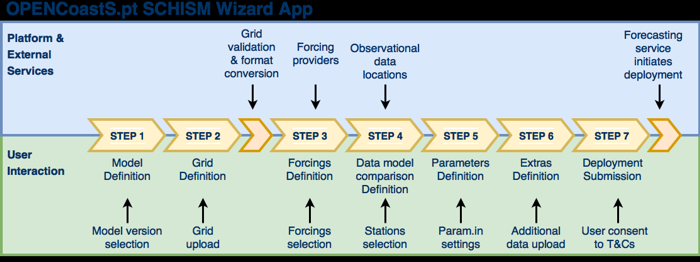
Fig 2. OPENCoastS workflow
Presently, all forecasts in OPENCoastS are made with the model SCHISM (http://ccrm.vims.edu/schismweb/). SCHISM is an open-source community-supported
modelling system based on unstructured grids, designed for the seamless simulation of 3D baroclinic circulation across lake/river/estuary/shelf/ocean scales (Zhang et al., 2016).
OPENCoastS allows for a suite of forcing options and provides access to the forecast results through a simple viewer that comprises maps of forecasted variables and charts of model data comparison at monitoring stations as well as time series of model results at virtual sensors (e.g. locations selected by the user):

Fig 3. OPENCoastS platform: architecture and interfaces
OPENCoastS is supported by LNEC's real time forecast framework WIFF - Water Information Forecast Framework (http://ariel.lnec.pt). WIFF started to be developed at LNEC in 2007 for the 2D circulation at the Aveiro lagoon (Oliveira et al., 2010). It was expanded to short wave propagation in the North Atlantic and Portuguese coasts in 2010 (Ribeiro et al., 2010) and to coupled wave-current circulation in 2016 (Fortunato et al., 2017) as well as 3D baroclinic predictions (Rodrigues et al., 2016). It also includes the circulation and water quality due to urban discharges (David et al. 2015).
OPENCoastS is supported by the EGI computational resources, through project H2020 EOSC-Hub, being available as one of its thematic services (https://www.eosc-hub.eu/catalogue/OPENCoastS)
